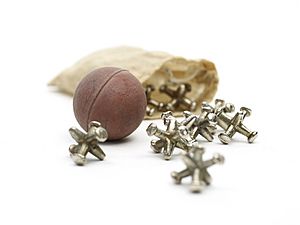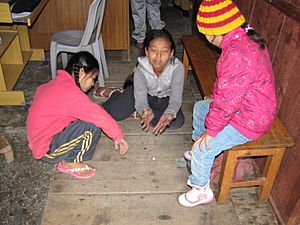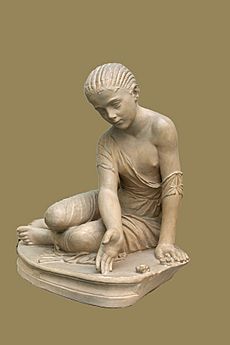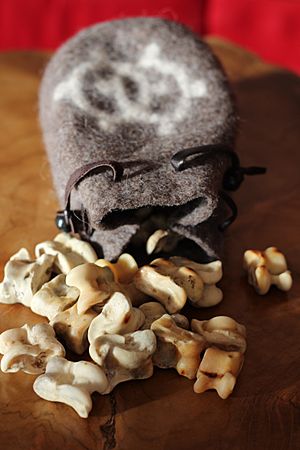Knucklebones facts for kids

Knucklebones, also known as Jacks, is a very old game. It's usually played with five small objects, or ten if you're playing jacks. Long ago, people used real animal bones, often from a sheep's ankle, as the game pieces. They would throw these bones up and catch them in different ways.
Today, knucklebones (or jacks) are usually made of metal or plastic. They often have six points or knobs. The goal is to be the first player to finish a special series of throws. A simple throw involves tossing one piece (the "jack") into the air. While it's in the air, you quickly pick up other pieces from the ground. You keep going until all five pieces are picked up. Other throws have fun names like "riding the elephant" or "frogs in the well"!
Contents
History of Knucklebones
The game of knucklebones is very old, even older than dice. Some ancient Greek writers believed a clever hero named Palamedes invented it during the Trojan War. He supposedly taught it to the Greek soldiers. Other stories say that the god Zeus gave golden knucklebones to Ganymede to cheer him up.
Some historians, like Herodotus and Plato, thought the game came from other countries. Plato said the Egyptian god Thoth invented it. Herodotus believed the Lydians (people from an ancient kingdom) created it during a time of hunger to keep their minds busy.
In ancient times, there were two main ways to play. The first way was much like today's game. Players would toss the bones up and catch them on the back of their hand. The Romans called this game tali. A famous painting found in Pompeii shows goddesses playing knucklebones.
The second way to play was more like gambling. Players would throw the bones onto a table, either from their hand or a cup. They would then count points based on how the bones landed. The bones used were usually from sheep, goats, or calves. They had different sides, and each side was worth a different number of points. For example, one side might be worth 1 point, and another 6 points.
Players would use four bones, and many different scores were possible. The highest score in ancient Greece was 40, called the Euripides. The lowest score, called the Dog, was just 1.
How to Play Modern Jacks
Today, the game of jacks often uses a small rubber ball and a set of ten metal or plastic jacks. Players usually decide who goes first by "flipping" the jacks. This means you put the jacks in your cupped hands, flip them onto the back of your hands, and then flip them back into your cupped hands. The player who catches the most jacks goes first.
To start the game, you scatter the jacks loosely on the ground. Then, players take turns bouncing the ball. While the ball is in the air, you quickly pick up a certain number of jacks. You must catch the ball before it bounces a second time.
The game usually goes in rounds. First, you pick up one jack at a time ("onesies"). Then, you pick up two at a time ("twosies"), and so on, until you pick up all the jacks. The player who finishes all the rounds first wins! You can make the game harder by using more jacks, like fifteen or twenty. There are also many different ways to play after the basic rounds, such as "double bounces" or "pigs in the pen."
Variations of the Game

This fun game has many different versions around the world!
- In Cork, Ireland, in the 1950s, a game called "gobs" was played using five small pebbles from the beach.
- Many African countries play a similar game using pebbles, but without a rubber ball.
- In Australia and New Zealand, people use five lamb bones or plastic pieces that look like bones. Players toss the pieces, catch them on the back of their hand, then flip them into their palm. Then, they toss one piece in the air and try to pick up the others from the ground before catching the tossed piece.
- In Israel, a game called kugelach or Chamesh Avanim ("five rocks") uses five small metal cubes instead of jacks. The cube is tossed into the air instead of bounced.
- In the North East of England, a game with five wooden cubes is called "chucks."
- In Turkey, children play beş taş ("five rocks") with five pebbles, similar to the Israeli game.
- In Brazil, people play with pebbles or small cloth bags filled with rice or sand.
- In Korea, a popular game called gonggi uses five weighted plastic "stones." Players throw one stone in the air, pick up another from the ground, and catch the first stone before it falls. The game continues until all stones are picked up. Then, players flip the stones onto the back of their hand to earn "years" towards a winning score.
- "Chinese Jacks" were popular in the United States in the 1980s. These are small, colorful plastic rings that link together to form jacks. The game play is similar to gonggi.
- The "taba game" (Jogo do Osso in Portuguese) is another name for knucklebones. It was very popular among cowboys (gauchos) in 19th-century Argentina. This game is played in a field where an animal bone is thrown into the air. People bet on how it will land.
Images for kids
-
Modern plastic gonggi pebbles from South Korea.
See also
 In Spanish: Juego de las tabas para niños
In Spanish: Juego de las tabas para niños









